Step-by-step Apache Guacamole Installation.
Recently, I decided to test Apache Guacamole and document the installation process.
Guacamole is an open-source software that enables remote access to desktops and servers via a web browser.
The easiest option I found was using Docker. Here’s the link to the official documentation.
The steps below were performed on a Debian system.
Install Docker
Adding the Docker repository:
1
2
3
4
5
6
7
8
9
10
11
12
13
# Add Docker's official GPG key:
sudo apt-get update
sudo apt-get install ca-certificates curl
sudo install -m 0755 -d /etc/apt/keyrings
sudo curl -fsSL https://download.docker.com/linux/debian/gpg -o /etc/apt/keyrings/docker.asc
sudo chmod a+r /etc/apt/keyrings/docker.asc
# Add the repository to Apt sources:
echo \
"deb [arch=$(dpkg --print-architecture) signed-by=/etc/apt/keyrings/docker.asc] https://download.docker.com/linux/debian \
$(. /etc/os-release && echo "$VERSION_CODENAME") stable" | \
sudo tee /etc/apt/sources.list.d/docker.list > /dev/null
sudo apt-get update
Installing Docker packages:
1
sudo apt-get install docker-ce docker-ce-cli containerd.io docker-buildx-plugin docker-compose-plugin
Verify the installation by running:
1
docker -v
Add the current user to the Docker group to avoid using sudo with commands:
1
sudo usermod -aG docker $USER
For this installation, I’m using the latest images, but for production use, it is recommended to use a specific version tag to avoid compatibility issues during upgrades or migrations.
Check out the available images on DockerHub Guacamole
1
2
3
docker pull guacamole/guacd
docker pull guacamole/guacamole
docker pull mariadb
Verify the downloaded images with the docker:
1
docker images

Now, let’s initialize the database with the command:
1
docker run --rm guacamole/guacamole:latest /opt/guacamole/bin/initdb.sh --mysql > initdb.sql

Create an .env file to store the access credentials:
1
nano .env
1
2
3
4
MYSQL_ROOT_PASSWORD=SuperSecretP@sswr0rd!@#$%^&*
MYSQL_DATABASE=guacamole_db
MYSQL_USER=guacamole_user
MYSQL_PASSWORD=SecretP@sswr0rd!@#$%^&*
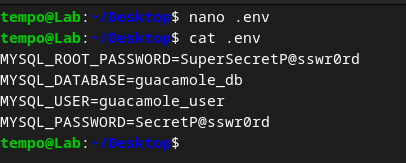
Create the docker-compose.yml file:
1
nano docker-compose.yml
1
2
3
4
5
6
7
8
9
10
11
12
13
14
15
version: "3"
services:
guacdb:
container_name: guacamoledb
image: mariadb:latest
restart: unless-stopped
environment:
MYSQL_ROOT_PASSWORD: ${MYSQL_ROOT_PASSWORD}
MYSQL_DATABASE: ${MYSQL_DATABASE}
MYSQL_USER: ${MYSQL_USER}
MYSQL_PASSWORD: ${MYSQL_PASSWORD}
volumes:
- "./db-data:/var/lib/mysql"
volumes:
db-data:
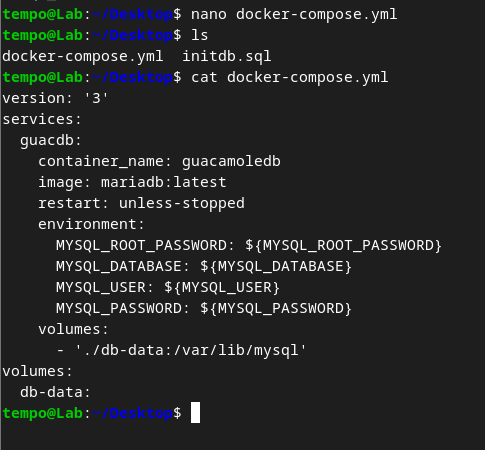
Start the database with:
1
docker compose up -d
For systems with docker-compose installed instead of the plugin, use docker-compose up -d.
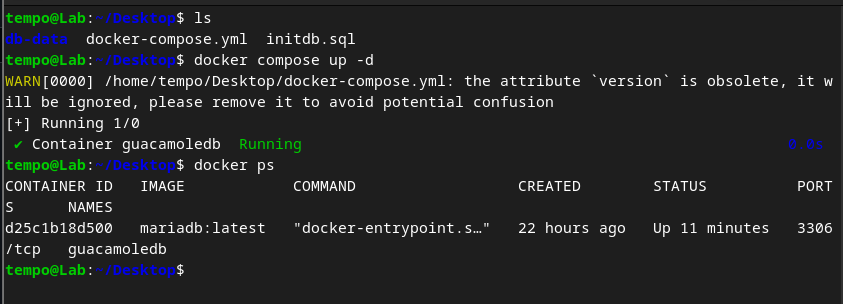
Next, copy the initdb.sql file into the container:
1
docker cp initdb.sql guacamoledb:/initdb.sql
Within the container, install MySQL client and initialize the database:
1
docker exec -it guacamoledb bash
1
2
3
apt-get update && apt-get install -y default-mysql-client
cat /initdb.sql | mysql -u root -p guacamole_db
exit

Shut down the database container:
1
docker compose down
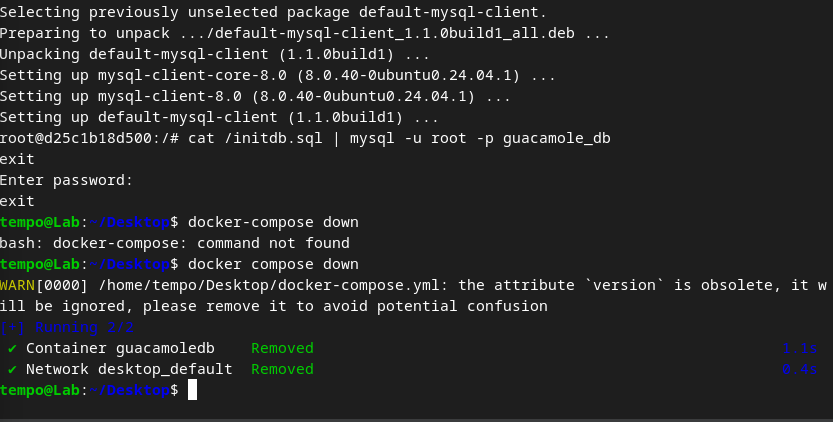
As a best practice, back up the database initialization file:
1
mv docker-compose.yml docker-compose.yml.bak

Create a new docker-compose.yml with all necessary configurations:
1
nano docker-compose.yml
1
2
3
4
5
6
7
8
9
10
11
12
13
14
15
16
17
18
19
20
21
22
23
24
25
26
27
28
29
30
31
32
33
34
35
36
version: "3"
services:
guacdb:
container_name: guacamoledb
image: mariadb:latest
restart: unless-stopped
user: mysql
environment:
MYSQL_ROOT_PASSWORD: ${MYSQL_ROOT_PASSWORD}
MYSQL_DATABASE: ${MYSQL_DATABASE}
MYSQL_USER: ${MYSQL_USER}
MYSQL_PASSWORD: ${MYSQL_PASSWORD}
volumes:
- "./db-data:/var/lib/mysql"
guacd:
container_name: guacd
image: guacamole/guacd:latest
restart: unless-stopped
guacamole:
container_name: guacamole
image: guacamole/guacamole:latest
restart: unless-stopped
ports:
- 8080:8080
environment:
GUACD_HOSTNAME: "guacd"
MYSQL_HOSTNAME: "guacdb"
MYSQL_DATABASE: ${MYSQL_DATABASE}
MYSQL_USER: ${MYSQL_USER}
MYSQL_PASSWORD: ${MYSQL_PASSWORD}
TOTP_ENABLED: "true"
depends_on:
- guacdb
- guacd
volumes:
db-data:
Start the Guacamole service:
1
docker compose up -d

Accessing Guacamole
Devemos acessar usando http://localhost:8080/guacamole
Tip
Guacamole is not directly accessible from the root. Add /guacamole to the address.
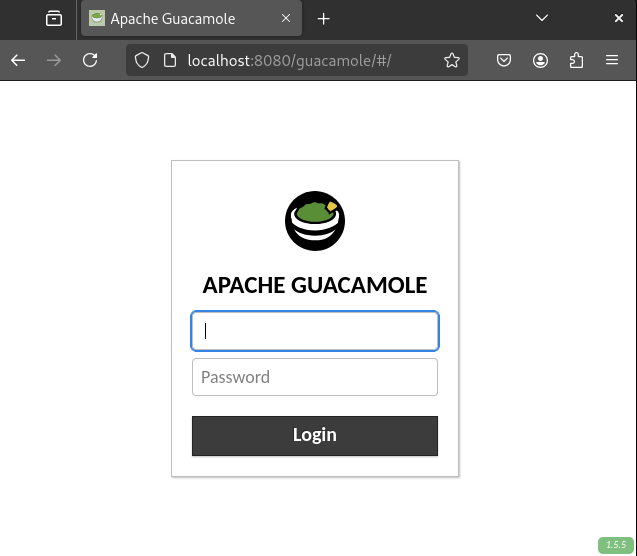
Danger
The default credentials are guacadmin/guacadmin
Warning
In our docker-compose, we enabled TOTP. This requires an app like Authy, 2FAS, or Google Authenticator for login. To disable this, remove the line
TOTP_ENABLED: "true".
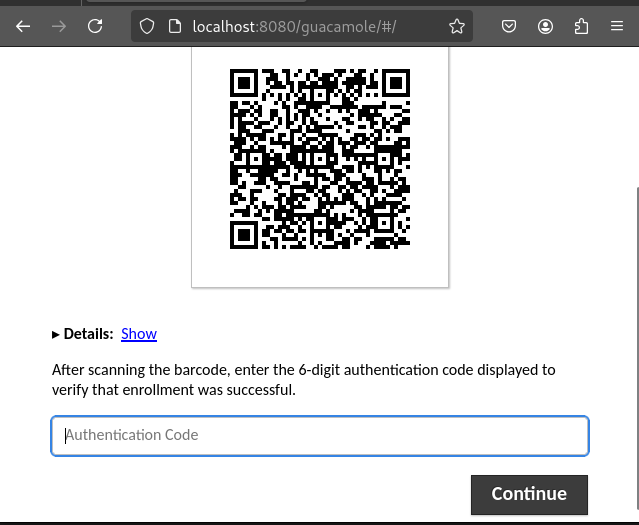
Allow inbound traffic on port 8080:
1
2
3
4
sudo iptables -A INPUT -p tcp --dport 8080 -j ACCEPT
sudo apt-get install iptables-persistent
sudo netfilter-persistent save
sudo iptables -L
Reference:
Enjoy Reading This Article?
Here are some more articles you might like to read next: